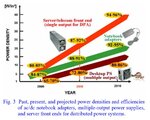T
treez
Guest
Hello,
What is the accepted limit of power density (in W/cubic inch) for a SELV (all voltages inside <42V) SMPS without a fan, but has potting around all the electronics, and has a metal heatsink.?
Is it about 100W/cubic inch?
Ambient temperature 85 degrees C max
(My 230VAC laptop power supply is 65W in 7 cubic inches. (10W/cubic inch))
What is the accepted limit of power density (in W/cubic inch) for a SELV (all voltages inside <42V) SMPS without a fan, but has potting around all the electronics, and has a metal heatsink.?
Is it about 100W/cubic inch?
Ambient temperature 85 degrees C max
(My 230VAC laptop power supply is 65W in 7 cubic inches. (10W/cubic inch))

